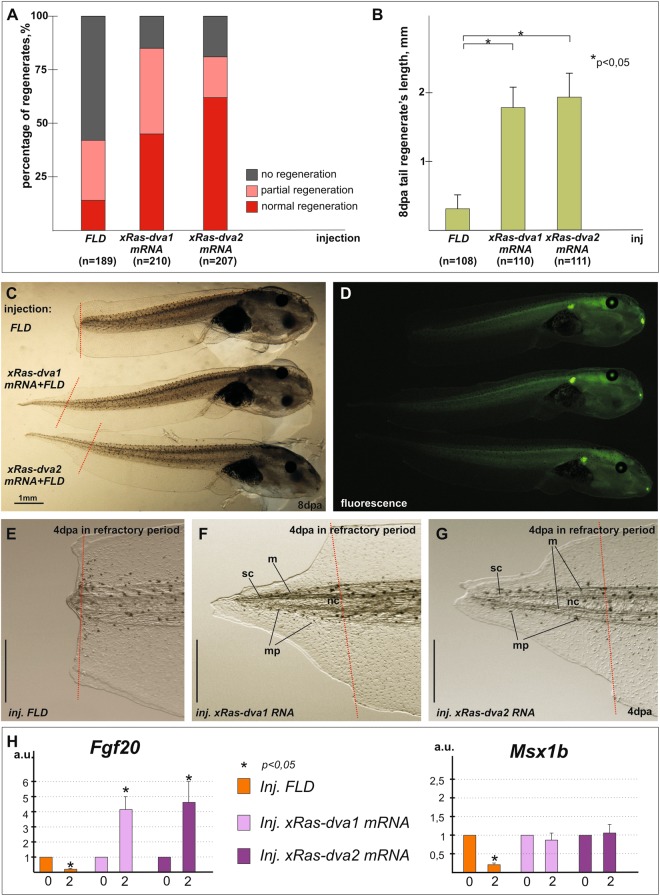Figure 8.
Rescue of the ability to regenerate tails during the refractory period in the X. laevis tadpoles. (A) Different rates of regeneration success in the refractory tadpoles with or without Ras-dva1/2 overexpression. The average percent mean values of regenerating tadpoles with different success rates marked by colors: gray - no regeneration, pink – partial regeneration, red – normal regeneration, in tadpole butches injected with fluorescein (FLD, as control) or overexpressing xRas-dva1 and xRas-dva2 mRNAs. n – number of injected tadpoles in three independent experiments. Differences of percent of normal regeneration between regenerates injected by FLD and mRNA are statistically significant, two-tailed t-test, p < 0,05. Percent differences of not regenerating tadpoles in FLD and mRNA injected tadpoles is statistically significant, two-tailed t-test, p < 0,05. (B) The measurements of the length of regenerated tail tips by 8 day after amputation of refractory tadpoles, developed from embryos injected by FLD (control) or xRas-dva1 or xRas-dva2 mRNA. n – number of injected tadpoles in three independent experiments. Two-tailed t-test, p < 0,001 (asterisk). The transmitted light (C) and fluorescent (D) images of regenerated tails of 8 dpa refractory tadpoles injected with fluorescein (FLD) or xRas-dva1 mRNA + FLD and xRas-dva2 mRNA + FLD. FLD refractory tadpoles show regeneration arrest which is common for refractory period. Refractory tadpoles with Ras-dva genes overexpression effectively regenerate their tails. (E–G) The transmitted light images of regenerating tail tips of control tadpoles (FLD) or xRas-dva1 mRNA and xRas-dva2 mRNA at 4 dpa in refractory period show regeneration arrest in control tip but normal regeneration of notochord (nt), spinal cord (sc), muscles (m), melanophores (mp) in the tadpole’s tails with xRas-dva1 or xRas-dva2 overexpression. The red dashed line indicates the amputation level. Scale bar 1 mm. (H) qRT-PCR analysis of the expression of early regeneration marker genes Fgf20 and Msx1b during the regeneration process (at 0 and 2 dpa) after amputation in refractory period in tadpoles tails injected with FLD or xRas-dva1 or xRas-dva2 mRNAs at early developmental stages. The scheme of samples harvesting is the same as described in Fig. 2A. The value of normalized PCR signal in the 0 dpa sample, harvested immediately after amputation, was taken as an arbitrary unit (a.u.) in each series. Dpa - days post amputation. Error bars indicate SD, t-test, p < 0.05 (asterisk).

